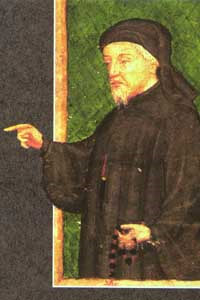|
||
     |
In “The Miller’s Tale,” Geoffrey Chaucer describes Alisoun, the old carpenter’s beautiful young wife, as an object of male desire. Chaucer calls forth natural images—the slimness of a weasel’s body, the tenderness of a chicken, the sweetness of fruit—to reveal her sexuality. “She was a far more pleasant thing to see/Than is the newly budded young pear tree;/And softer than the wool is on a wether,” he writes in this second story of Canterbury Tales, which chronicles 30 medieval pilgrims traveling to Canterbury, England, taking turns as raconteur to pass the time.

While Chaucer’s evocation of nature in “The Miller’s Tale” is often seen as a departure from his earlier philosophical poetry, Mark Miller, an associate professor of English, has a different view. He believes that all of the tales, written at the end of the 14th century, are in fact quite philosophical.
In Philosophical Chaucer: Love, Sex, and Agency in the Canterbury Tales (Cambridge University Press, 2005), Miller challenges the notion that the poet abandoned his reflective roots, which are explicit in “The Knight’s Tale,” Canterbury’s opener. Instead, he believes, Chaucer uses natural images as a context for philosophical musing, beginning with “The Miller’s Tale” and continuing through the remaining stories, exploring issues of gender, sex, and love.
“The standard way to understand Chaucer’s career is to see his knight’s tale as the last gasp of philosophical poetry,” Miller says from his cubbyhole office in Gates-Blake Hall. “But it’s wrong,” he declares, arguing that Chaucer “continues to have many of the philosophical interests he has always had and gets a lot more subtle and engaging in his literary texts.”
Influenced by Boethius’s Consolation of Philosophy and Guillaume de Lorris’s Romance of the Rose, Chaucer began as a philosophical poet, Miller says, writing “The Knight’s Tale” earlier in his career, most likely by 1386. He adapted it for a new project, Canterbury Tales—a collection of stories that editors later divided into ten fragments.
Miller opens Philosophical Chaucer with a discussion of “The Miller’s Tale” because it offers the most immediate and obvious contrast to the knight’s, which includes conversations on love and courtly manners. He then examines the philosophy in other tales, devoting each chapter to some philosophical problem, from Boethius’s agency or autonomy to Lorris’s utopia, as it’s studied in the story.
In “The Miller’s Tale” handsome Alisoun is adored by three men: her elderly carpenter-husband John, the scholar Nicholas, and the clerk Absolon. The men’s courtly pursuits and Alisoun’s conquests form the basis for Chaucer’s analysis of human action and happiness. Natural imagery is at the heart of the miller’s narration—as is his belief that nature determines what people want, which in turn is provided by nature, as demonstrated by Alisoun’s earthy appeal.
The miller’s theory becomes more complicated when the traditional gender roles are reversed. Alisoun possesses what are often seen as masculine characteristics, such as having sexual desires and acting upon them. And while the men are supposed to control the courtship, their way of getting the girl amounts to avoiding her and making fools of themselves. With these paradoxes, Miller argues, Chaucer faults the narrator’s expectations, showing that sexuality and gender differences are more complicated than the stereotypes suggest and not easily resolved with a single view.
Critics contend that Chaucer simply borrowed philosophical ideas from his poetic influences in the Later Middle Ages’ Aristotelian tradition, but Miller claims in his book that the poet’s a philosopher in his own right, notes D. Vance Smith, an associate professor of English at Princeton. “There really isn’t anything else like it,” says Smith, who read an advance copy as a peer reviewer. “Few people have treated Chaucer with that seriousness, as someone who thinks though serious philosophical problems.”
Chaucer does not adopt one philosophy, Miller says, but rather assumes a set of ideas about philosophical problems, such as rationality’s role in deliberation and action, and the basis of love. More important to Chaucer is understanding how people make sense of complicated issues. Thus each Canterbury narrator takes up a different problem—which a sole viewpoint can’t explain.
For example, in “The Clerk’s Tale”—included in Canterbury’s fourth fragment and the subject of Miller’s final chapter—the narrating clerk relates the travails of Griselde, who remains loyal to her husband Walter even as he makes her suffer, observing that real love is unconditional. But some moments in the tale don’t fit into this vision, Miller says, as Walter, a marquis, puts Griselde, who’s not from nobility, to the test again and again. “What the clerk gives Chaucer is an opportunity to explore and exhibit a smart, thoughtful engagement with this problem,” he explains. “And that’s what’s philosophical about the poem, what makes it a product of genuine thought, as opposed to a bogus gesture of theoretical clarity.”
Similarly, Miller is trying to “generate a vocabulary that can let us theorize how those phenomena are understood” in Canterbury. He suggests, “Let’s look at how this culture conceived of those issues.” With his book, he hopes scholars will be better equipped to discuss Chaucer’s philosophy and perspectives on gender and sexuality.